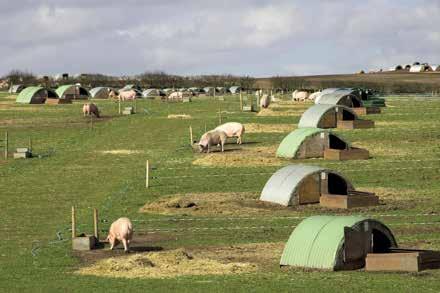
18 minute read
Pig & Poultry
Pig industry posts further reductions in antibiotics
Pig producers used fewer antibiotics last year – with the amount prescribed falling by 5% on UK farms in 2020 – a total reduction of 62% since 2015.
The decline comes despite disease outbreaks and challenges caused by supply chain disruptions during the coronavirus pandemic which meant pigs spent more time on farm than usual.
Antibiotic use during 2020 reduced to 105mg/PCU compared with 110mg in 2019 and 278mg in 2015, according to data collected using the electronic medicine book.
The book represents more than 95% of pigs slaughtered in the UK and continues the downward trend since recording started – although swine dysentery in 2019 and early 2020 temporarily halted progress.
The overall result is close to the target of 99mg set by the UK pig industry. AHDB pork sector strategy director Angela Christison said the reduction was a good result in a difficult year,.
She said: “The industry understands how important responsible antibiotic use is and that is why there are tough targets and we work together towards them. The sector has delivered sustained reductions since recording began via eMB in 2015.
“This continued improvement, despite disruption to pig flow during the pandemic, is a credit to collaboration between producers, vets and the industry as a whole.”
Usage of the highest priority critically important antibiotics (HP-CIAs) remains at a very low level, although there was a slight increase from 0.04 mg to 0.05 mg. No colistin use has been reported in 2020.
HP-CIAs, as categorised by the European Medicines Agency (EMA), are the most important for human medical health and reductions in their use has been a focus for all UK farm animal sectors since stewardship efforts have stepped up.
Other options
Mandy Nevel, AHDB head of animal health and welfare, said: “The EMA advice, which Pig Veterinary Society guidance supports, is that veterinary surgeons should prescribe a lower priority alternative to HP-CIAs unless there is no other option.
“This could explain why, despite the reducing trend overall, we are seeing an increase in use in some lower priority antibiotics such as neomycin.”
Alternatively, these could be short term adjustments as the industry accommodates the phasing out of therapeutic zinc oxide, which treats postweaning diarrhoea in piglets, said Dr Nevel.
The pig sector has made big strides in reducing antibiotics
“Either way, while the proportion of these antibiotics being used remains low, as does resistance reported through Government surveillance, we must continue to monitor these trends and work to understand the reasons for changes in their use.”
Collaboration within the industry has been one of the success factors behind the reductions achieved.
The survey allows the industry to look at the more nuanced variations in individual antibiotic use to identify potential reductions.
Dr Nevel added: “The challenges in the industry during the past year highlight not just the importance of this cross-industry approach in our sustained drive for good stewardship, but also the need for antibiotics to safeguard pig welfare.”
Gut health ‘key to reducing antimicrobials’
Low stress levels are key to reducing gut inflammation and the unnecessary use of antibiotics in pigs, suggests a Nuffield study.
“With the ever-increasing pressure to reduce antimicrobials and the looming crisis of antimicrobial resistance, pig producers must review their unit in a holistic manner with gut health at its centre,” says author Heidi Hall.
Ms Hall examined ways farmers can manage herds with minimal requirement for antibiotics. “Harnessing the power of the microbiome, the population of bacteria which reside in the gut, is the key to sustainable pig production.”

Performance changess
She adds: “We need to routinely measure microbiome changes alongside stress levels in animals, prior to and during research trials, so that we can better understand any performance changes seen.”
Medication reduction in the breeding herd was achievable by improving immunity, vaccination protocols and a focus on gut health. This should result in further improvements in progeny performance through maternal transfer.
“We need to further understand the influence we have on gut health through effective monitoring on farm and in trials. We can then look to manipulate gut health to favour a microbiome which is best suited to the production system.”






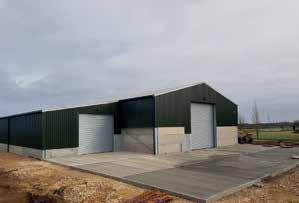

www.agriculturalbuildingconstruction.co.uk Email: info@agriculturalbuildingconstruction.co.uk Tel: 07981 031613 / 01945 660231 | Wisbech, Cambs So why should you call us today? • Free quotation • Competitive rates • All work fully insured • Skilled, committed staff • Highly professional service Suppliers of Agricultural Buildings with • Plant hire available with operator associated groundworks and concrete flooring provided by our sister company SJ Stanberry & Sons Ltd
Agricultural Building Construction Ltd operate nationwide, providing steel framed buildings with associated groundworks. Our aim is to provide a high quality product at an affordable price combined with a customer service second to none. Buildings for housing livestock to storing grain in vermin-free and farm assured conditions. • Dairy housing • Beef housing • Sheep housing • Crop storage • Silage clamps • Grain stores • Workshops • General stores
Concrete Flooring Speciali •INTERNAL OR EXTERNAL •STEEL FIXING •BRUSH, TAMP OR POWER st
SJ STANBERRY&SONFLOATFINISHES SLTD •FOUNDATIONS Concrete Flooring SpecialistSee us at Agri Expo -March 7th• POULTRYUNITS AND STABLE YARDS
SJ STANBERRY&SONSLTD•INDUSTRIAL, AGRICULTURAL • MATERIAL ADVICE AND COSTING See us at Agri Expo -March 7th OR COMMERCIAL •INTERNAL OR EXTERNAL •SILO BASES •APRONS &SHED FLOORS •ANAEROBIC DIGESTION • INDUSTRIAL, AGRICULTURAL •INDUSTRIAL, AGRICULTURAL•STEEL FIXINGTANK BASES OR COMMERCIAL • INTERNAL OR EXTERNAL •BRUSH,•GRAIN, POTATO& MACHINERYSTORES OR COMMERCIALTAMP OR POWER • STEEL FIXING • BRUSH, TAMP OR POWER FLOAT FINISHES •INTERNAL OR EXTERNAL •STEEL FIXING FLOATFINISHES •FOUNDATIONS •PATHS, PATIOS AND DRIVEWAYS •GROUNDWORKS & •BRUSH, TAMP OR POWER FLOATFINISHES •FOUNDATIONS • POULTRYUNITS AND • POULTRYUNITS AND STABLE YARDS • MATERIAL ADVICE AND COSTING 01945 870076 •nationwide coverage •sales@sjstanberry.com•www.sjstanberry.com PREPARATION 01945 870 076 • nationwide coverage • www.sjstanberry.com • sales@sjstanberry.com STABLE•SILO YARDS BASES ••APMATERIAL ADVICE ANDRONS &SHED FLOORS •ANAEROBIC COSTING DIGESTION •SILOTANK BASES BASES •APRONS &SHED FLOORS•GRAIN, POTATO& •ANAEROBIC DIGESTIONMACHINERYSTORES •PAT TANK BASESHS, PATIOS AND •GRAIN, POTATO&DRIVEWAYS MACHINERYSTORES•GROUNDWORKS & •PATHS, PATIOS ANDPREPARATION DRIVEWAYS 01945 870076 •GROUNDWORKS & PREPARATION •nationwide coverage •sales@sjstanberry.com•www.sjstanberry.com
• FOUNDATIONS • POULTRY UNITS AND STABLE YARDS • MATERIAL ADVICE AND COSTING • SILO BASES
Concrete Flooring Specialist SJ STANBERRY&SONSLTD Concrete Flooring Specialist SJ STANBERRY&SONSLTD Concrete Flooring Specialist SJ STANBERRY&SONSLTDConcrete Flooring Specialist SJ STANBERRY&SONSLTD See us at Agri Expo -March 7thSee us at Agri Expo -March 7thSee us at Agri Expo -March 7th See us at Agri Expo -March 7th • APRONS & SHED FLOORS • ANAEROBIC DIGESTION TANK BASES • GRAIN, POTATO & MACHINERY STORES • PATHS, PATIOS, DRIVEWAYS • GROUNDWORKS & PREP •INDUSTRIAL, AGRICULTURAL OR COMMERCIAL •INTERNAL OR EXTERNAL •STEEL FIXING •BRUSH, TAMP OR POWER FLOATFINISHES •FOUNDATIONS • POULTRYUNITS AND STABLE YARDS • MATERIAL ADVICE AND COSTING •SILO BASES •INDUSTRIAL, AGRICULTURAL OR COMMERCIAL •INTERNAL OR EXTERNAL •STEEL FIXING •BRUSH, TAMP OR POWER FLOATFINISHES •FOUNDATIONS • POULTRYUNITS AND STABLE YARDS • MATERIAL ADVICE AND COSTING •SILO BASES •INDUSTRIAL, AGRICULTURAL OR COMMERCIAL •INTERNAL OR EXTERNAL •STEEL FIXING •BRUSH, TAMP OR POWER FLOATFINISHES •FOUNDATIONS • POULTRYUNITS AND STABLE YARDS • MATERIAL ADVICE AND COSTING •SILO BASES •INDUSTRIAL, AGRICULTURAL OR COMMERCIAL •INTERNAL OR EXTERNAL •STEEL FIXING •BRUSH, TAMP OR POWER FLOATFINISHES •FOUNDATIONS • POULTRYUNITS AND STABLE YARDS • MATERIAL ADVICE AND COSTING •SILO BASES •APRONS &SHED FLOORS •ANAEROBIC DIGESTION TANK BASES •GRAIN, POTATO& MACHINERYSTORES •PATHS, PATIOS AND DRIVEWAYS •GROUNDWORKS & PREPARATION •APRONS &SHED FLOORS •ANAEROBIC DIGESTION TANK BASES •GRAIN, POTATO& MACHINERYSTORES •PATHS, PATIOS AND DRIVEWAYS •GROUNDWORKS & PREPARATION •APRONS &SHED FLOORS •ANAEROBIC DIGESTION TANK BASES •GRAIN, POTATO& MACHINERYSTORES •PATHS, PATIOS AND DRIVEWAYS •GROUNDWORKS & PREPARATION •APRONS &SHED FLOORS •ANAEROBIC DIGESTION TANK BASES •GRAIN, POTATO& MACHINERYSTORES •PATHS, PATIOS AND DRIVEWAYS •GROUNDWORKS & PREPARATION 01945 870076 •nationwide coverage •sales@sjstanberry.com•www.sjstanberry.com 01945 870076 •nationwide coverage •sales@sjstanberry.com•www.sjstanberry.com 01945 870076 •nationwide coverage •sales@sjstanberry.com•www.sjstanberry.com01945 870076 atio ide ales@sjstanb jstanb





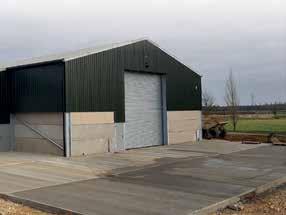


Study identifies genomic pathway could produce heavier eggs
Egg weights in laying hens can be increased by a new approach to analyse and target birds with specifi c genes for selected breeding, suggests a study.
Eggs typically weigh 50-70g – depending mainly on the age of the hen and its genotype. Weight is a highly heritable trait, meaning variance between hens is largely a direct result of genetics – and hugely important when it comes to profi tability.
Experts from biological insights company Synomics analysed data from more than 1,000 laying hens. Researchers then singled out and examined the genetic information regulating traits which govern egg weight.

Findings were then converted into an industry-standard genetic evaluation model, making it easier to select the best birds. In this case, it meant the accuracy of the genetic predictions made increased by 49%.
Synomics said its technique was the “missing link” between the huge amounts of raw data held by farmers and scientists – and the company’s own research and develop team. They were able to interpret the data quickly, highlighting areas of interest.
A hen can have upwards of 20,000 genes – so being able to narrow down the search to a mere 122 that could hold the key to a heavier egg has a big impact on the speed of subsequent research and development.
Faster benefits
Assessing genetic information like this makes it easier to identify crops or animals that are healthier, more disease resistant, or deliver higher yields, says Synomics. Scientists can then help improve productivity market more rapidly and at less expense.
Researchers say the fi ndings can help improve profi tabilty
Synomics chief executive Peter Kristensen said the business had developed its own platform to enable animal and crop scientists and producers to get a better understanding of what drives key production traits and innovate accordingly.
“We are giving scientists, farmers and food producers the ability to learn more about the animals they breed and the crops that they grow with insights they have not been previously able to liberate from the data they already hold.”
Stay vigilant for bird flu, producers warned
Poultry producers are being warned to remain vigilant following the lifting of heightened biosecurity measures imposed last winter due to avian fl u.
Mandatory enhanced biosecurity requirements – imposed across Great Britain in November 2020 to protect fl ocks from the disease – were lifted on 15 May after the risk of bird fl u in poultry was reduced to ‘low’.
Defra, the Scottish Government and the Welsh Government have been working with the industry and bird keepers to ensure strict biosecurity measures in and around poultry premises to help keep fl ocks safe.
In a joint statement, Great Britain’s three chief veterinary offi cers said: “This will be welcome news for bird keepers across the country who have put great effort into keeping their fl ocks safe this winter.
“We have taken swift action to contain and eliminate this disease, and we urge all bird keepers – whether they have just a few birds or thousands – to continue to do their bit to maintain strict biosecurity measures on their premises.”
Low risk does not mean no risk, said the statement.
All poultry and bird gatherings are now permitted, provided organisers notify the Animal and Plant Health Agency at least seven days before the event takes place. Organisers and attendees must comply with the provisions of the new general licence.
Public health advice is that any risk to human health is low. Food standards bodies advise that avian infl u poses a very low food safety risk for UK consumers, and it does not affect the consumption of poultry products – including eggs.

Avian fl u prevention
Fence off streams and watercourses Net or cover ponds Remove any wild bird feed sources Deter wild birds by using decoys Cleans and disinfect concrete areas Use wood shavings in wet areas Limit the number of people on-site Use disinfectant foot dips
Check ventilation systems as temperatures rise
Pig producers should ensure ventilation is in good working order to prevent heat stress as summer temperatures rise.
“We’re now starting to see sustained higher temperatures, which means pigs will become susceptible to heat stress,” explains Mark McFarland, feed additive product manager at Lallemand Animal Nutrition.
Heat stress can signifi cantly impact productivity levels, with suffering pigs exhibiting irregular feeding behaviour and a loss of appetite, resulting in lower feed intakes and subsequently, inconsistent and reduced performance.
Proper ventilation
Carrying out simple maintenance like removing dust and applying grease to moving parts where needed, can make a huge difference to the amount of clean and cool air reaching the pigs, says Mr McFarland.
As well as ensuring proper ventilation, it is important producers look out for the signs of heat stress, including panting, loss in weight and lethargy, and adjust management practices accordingly.
“Feeding smaller portions regularly can help to prevent gorging which can lead to bloat and sudden death. Meals should be available during the cooler parts of the day as pigs will be more likely to empty troughs reducing waste and poor trough hygiene.”
Eating behaviour
For those who are experiencing reduced or varied feed intakes, particularly in sows, Mr McFarland advises adding a proven probiotic supplement to the diet. This can help encourage pigs to adapt their eating behaviour to the heat stress conditions.
“Ultimately, a combined approach of adapting feeding patterns and making sure environmental factors like ventilation and drinking water systems are functioning properly will help provide pigs with the best protection against heat stress.”
To help producers monitor the likelihood of heat stress occurring, Lallemand are providing free hand-held temperature and humidity monitors while stocks last.
Good ventilation is vital to avoid heat stress, says Mark McFarland (right).
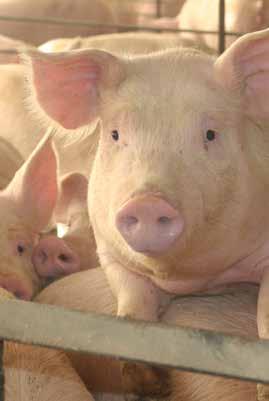
GLYN HAMER MILL MIX LTD


WE PROVIDE MOBILE FEED MILLING AND MIXING SERVICES FOR ALL BREEDS OF ANIMALS AND POULTRY, FROM STRAIGHT ROLLED CEREALS OR HAMMERMILLED PULSES TO COMPLETE MIXED RATIONS AND FEED BIN TRANSFERS.
With numerous suction and discharge options including directly into feed bins or separate bunkers, we are able to provide an efficient, traceable and consistently high standard of service for our customers.
Based in the West Midlands we run a fleet of modern ‘Tropper’ machines specifically built for precise mixing and accurate weighing operated by our experienced, friendly drivers.
To discuss your farm’s requirements please give us a call on: James - 07584 582 598 Glyn on 07976 548766 / 01568 750 183 E: info@glynhamermillmix.co.uk W: www.glynhamermillmix.co.uk
Reduce your feed costswith Tropper mixed diets Harbro diet: £238/tonne* Compound of same spec: £276/tonne

Improved performance
Recent results on Harbro Tropper diets: Growth rate: 1030g/day FCR: 2.39 Option to use own raw materials
According to cost/spec/availability. Bespoke rations
Tailored to the requirements of your pigs.
LOW CARBON PORK
Improved gut health
Meal grist reduces stress and improves gut health.
Tropper rations using home grown or locally sourced grain reduces your carbon footprint.
Lee Thompson - Midlands/South England: 07990 241372 Sam Parker - North England: 07384 254115
*Based on minimum order of 30 tonnes/week. Prices correct as at February 28 2021.


Elanco offers free E.coli tests on piglets
Free diagnostic testing is being offered by animal health company Elanco to tackle Post Weaning Diarrhoea (PWD) in piglets.
The test identifi es the bacterial strain ready for appropriate vaccination. Farmers should access the service through their vet practice, who will then prescribe and advise on the appropriate vaccination if necessary.
“The most viable option for PWD control is vaccination,” says Elanco principal technical adviser Frédéric Vangroenweghe. “But for this to be effective and lead to increased productivity, a positive diagnosis of the cause should be obtained.”
Farmers should request a test from their vet at the fi rst onset of PWD, which typically occurs in the fi rst three weeks after weaning. Apositive test for the F4 or F18 strain of E.coli means the bacteria is likely to remain or increase in future batches of piglets.
To effectively prevent To effectively prevent against the disease while promoting gut health, Prof. Vangroenweghe recommends administering the Coliprotec vaccine through drinking water. “This vaccination has been shown to help reduce reliance on antibiotics and should alleviate the requirement of zinc oxide in ment of zinc oxide in feed,” he says.
The testing kit can be requested from vets
www.bigdutchman.de
FLEXIBLE MODULAR SYSTEM
Big volumes of eggsperience: NATURA
More than 10.5 million bird places in the UK, 80 million in Europe and 102.7 million hens worldwide in NATURA – the flexible modular system.
Newquip Limited, NQ House, Conygarth Way Leeming Bar Business Park, Leeming Bar Northallerton, North Yorkshire DL7 9EE Tel. 01677 428600, enquiries@newquip.co.uk


Protect people and poultry from red mite
Egg producers are being reminded of the risk to worker welfare as the summer red mite season draws near.
Many producers are aware of the signifi cant impact red mite has on bird productivity and welfare. But it is also important to remember the risks it poses to workers, says Katie Pitman, technical veterinary adviser at MSD Animal Health UK.
“The fact red mite could have an impact on staff is sometimes unknown, as publicity tends to focus on the impact the parasites have on birds. But treating birds will also benefi t your workforce as it can prevent red mite from spreading to people.”
Red mite can crawl onto workers leading to irritation which can cause dermatitis and other skin conditions. This also means there is a greater risk of spreading the mite from shed-to-shed, to other sites, or even taking it home.
Warmer weather and increased humidity both create optimal conditions for red mite to multiply, meaning the parasite completes its lifecycle, from egg to adult, in just seven days, says Ms Pitman.
“There is an increased risk to workers during the summer months, so if you spot red mite it’s important that treatment is carried out as soon as possible to prevent the infestation from worsening.”
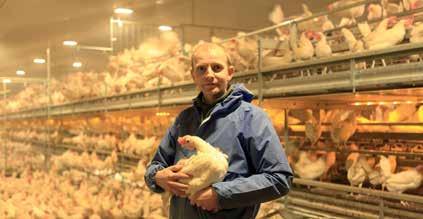
Different treatments
When it comes to selecting treatment, some options are easier and less time consuming than others. Chemicals, detergents and products containing diatomaceous earth can be unpleasant and can take a great deal of time to spray all areas of the shed.
A product like Exzolt (fl uralaner) is easily administered through drinking water. It is quicker to ad-
NEW HORIZONTAL ROTOR HEADER OPTION
TO SUIT ANY BALE AND ANY LOADER SIZE
Spread-a-Bale®

LINEAR SPREAD PATTERN: ONE METRE WIDE; 12 METRE THROW SAVING TIME SAVING STRAW - UPTO 50% HIGH WELFARE, MINIMAL DUST HD & XL OPTIONS AVAILABLE IDEAL FOR BEDDING PIG ARCS & LONG BUILDINGS
M: 07904899289 - Dave Bull T: 01244 394258 E: sales@spread-a-bale.com
Effective treatment can stop red mite in its tracks
minister and does not require people to move among the birds. so red mite are less likely to transfer onto staff and cause irritation.
The update to the SPC has been awarded based on results from a multi-site EU fi eld study in commercial egg production farms, which demonstrated the elimination of poultry red mite from infested chickens following treatment with Exzolt.
British pork takes centre stage in China
High-quality UK pork was showcased at Asia’s largest food and beverage show – as pig industry leaders continue to seek inroads into the valuable Chinese market.
The Agriculture and Horticulture Development Board once again had a presence at SIAL China – a major exhibition which sets the benchmark for overseas companies stepping into the Asian marketplace.
The event in late May was seen as a signifi cant networking opportunity for exporters looking to grow their business in this all-important region. Covid restrictions meant the AHDB stand was hosted by its China-based representative Holly Chen..
AHDB Export Manager Susan Stewart said: “This is a hugely important event which provides valuable networking opportunities for UK exporters and allows us to showcase our pork to a number of key infl uencers and importers.
“China remains a key market for our pork exports and despite the challenges of the last year, AHDB is committed to exploring all potential opportunities within this region and continuing to develop strong relationships to support trade between the UK and China.”
The value of pork exports has risen dramatically over the last few years, rising 46% to a staggering £279 million in 2020 – up from £191 million in 2019. China remains a key destination for exports of pork cuts not consumed in the UK.
As part of its ongoing export activities in China, the AHDB also hosted a media event for Chinese journalists who sampled four UK pork dishes, prepared by Chef Su at the restaurant in the Sofi tel hotel.


